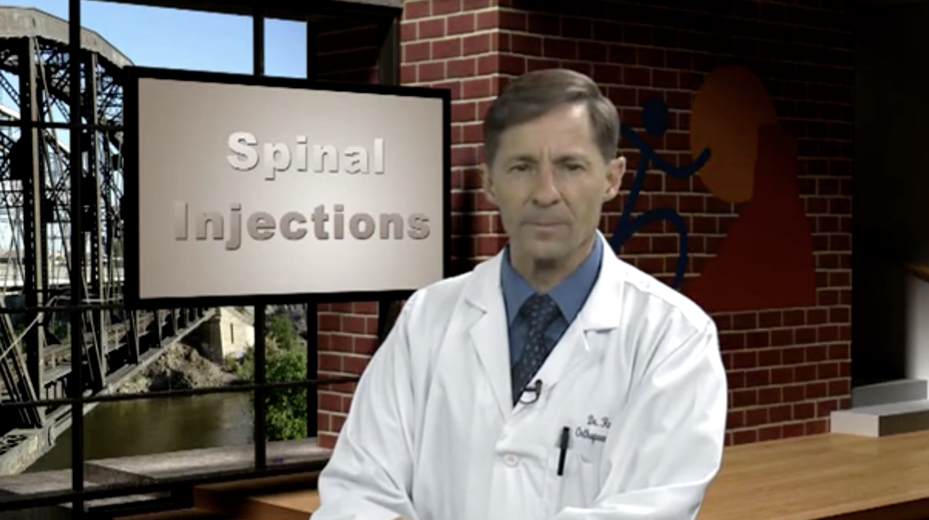How to Treat Back Pain with Spinal Injections
December 1, 2022
Our spines have several complex forms and functions. In this blog, we’ll discuss what happens when problems develop in our spine and some of the treatments that are available to help those who experience spinal pain.
The Complexities of the Spine
Your spine is made up of 24 small bones, called vertebrae, which are stacked on top of one another. Muscles, ligaments, nerves, and intervertebral disks are additional parts that also play a role in the spine.
The Levels of the Spine
The upper level of the spine lies above the rib cage and is called the “cervical spine.” The cervical spine is made up of 7 bones. The middle portion is called the “thoracic spine” because this is where the ribs are located and attached.
The last 5 spinal bones below the rib cage are called “lumbar vertebrae.” This name explains why we refer to the lower back as the “lumbar region.” The lumbar region is also more flexible–leading to more injuries and health problems.
Discs, Ligaments, and Tendons
While the bones of the spine provide strength and stability, there are flexible portions between the bones called “discs.” Discs allow for movement of your back. Each spinal bone has multiple attachments to other bones called “ligaments” and muscle attachments called “tendons.”
What Does the Spine Do?
The spine protects the spinal cord, which is an extension of nerves that runs from the brain to the lowest part of the spine. From the spinal cord emerge nerves that go to every part of our skin, joints, and muscles.
Common Spinal Issues
While our spine is the central anchor of the skeleton, it can frequently be a source of pain caused by a list of diseases. When people visit their doctor, they use several methods to diagnose common spinal issues.
Diagnosing Problems
The physician will do different physical examination techniques to identify portions of the spine that are functioning properly, as well as identify anything that might be amiss. Using a medical test to identify a condition is called a “diagnostic test,” and using a medical procedure to treat a condition is called a “therapeutic intervention.”
Spinal Injections
Sometimes a medical procedure can be both diagnostic and therapeutic. A common diagnostic and potentially therapeutic treatment for spinal conditions is called “injection therapy.”
There are different types of injections used around the spine, so it can be important to understand the purpose behind each of them.
Epidural Injection
The most common spinal injection is called an “epidural injection.” This injection involves placing a medication into the spinal canal, where the spinal cord and nerves are located. Epidural injections can be diagnostic, therapeutic, or both, depending on the type of medication used.
Most people have heard the term epidural block associated with the type of anesthesia used in childbirth. For anesthetic purposes and for diagnostic purposes in the spine, the epidural injection places a numbing medication into the nerves at the lower back or lumbar region, which stops any pain sensation in that area.
The Effects of an Epidural
The effect is temporary and eventually wears off after a few hours at best. An epidural injection may be therapeutic by using an anti-inflammatory medication like cortisone. Cortisone has the potential to reduce swelling of structures around the nerves that cause irritation, like joint arthritis, and can result in weeks or even months of pain relief.
Administering an Epidural
This injection is generally given in a procedure room equipped with a special x-ray device called a fluoroscope. A fluoroscope allows the physician performing the injection to be precise in placing the medication in the right location to identify or treat pain.
Epidural injections are named by the location of the spine where they are given, so an injection into the neck would be a cervical epidural, while an injection into the lower spine would be a lumbar epidural injection. Each injection would only be expected to address problems present in that area.
When to Use The Injection
Epidural injections are frequently used for spinal conditions that involve nerve pain caused by pressure on the nerves related to disc problems or tightness in the spinal canal.
Facet Joint Injections
A different injection is called “facet joint injection.” There are joints located behind the spinal canal in between the bones called “facets.” The facet joints allow us to flex and bend.
Problems with Facet Joints
These same facet joints are a common location for pain in spinal conditions caused by arthritis or osteoarthritis. When painful spinal conditions are not related to nerve pain, the facet joints are the most common source of treatable pain.
Administering Facet Injections
Use of the fluoroscope is critical to ensuring the injections are placed properly for a facet injection. Multiple injections are prescribed because the results of the injections may dictate further treatment.
When the injections are successful, there are therapies that can permanently block the nerves around the facet joints and allow for significant long term pain relief. When the initial facet injection is not successful, it may guide the physician towards another area of the spine to look for the source of the pain.
S-I Joint Injections
Injections into the attachment between the pelvic bone and the tail bone are called sacro-iliac injections or S-I joint injections. These, too, require the use of a fluoroscope and can be both diagnostic and therapeutic.
Working With Your Physician
Injection therapy is generally safe but not without some risk due to allergic reactions to medications, possible infections, and very rare but potentially catastrophic events around the spinal cord. Injection therapy for spinal conditions is an important medical option for those with spine pain.
For help with spinal pain, contact The Bone and Joint Center of Yuma. Dr. Clark can help you with persistent pain using spinal injections.